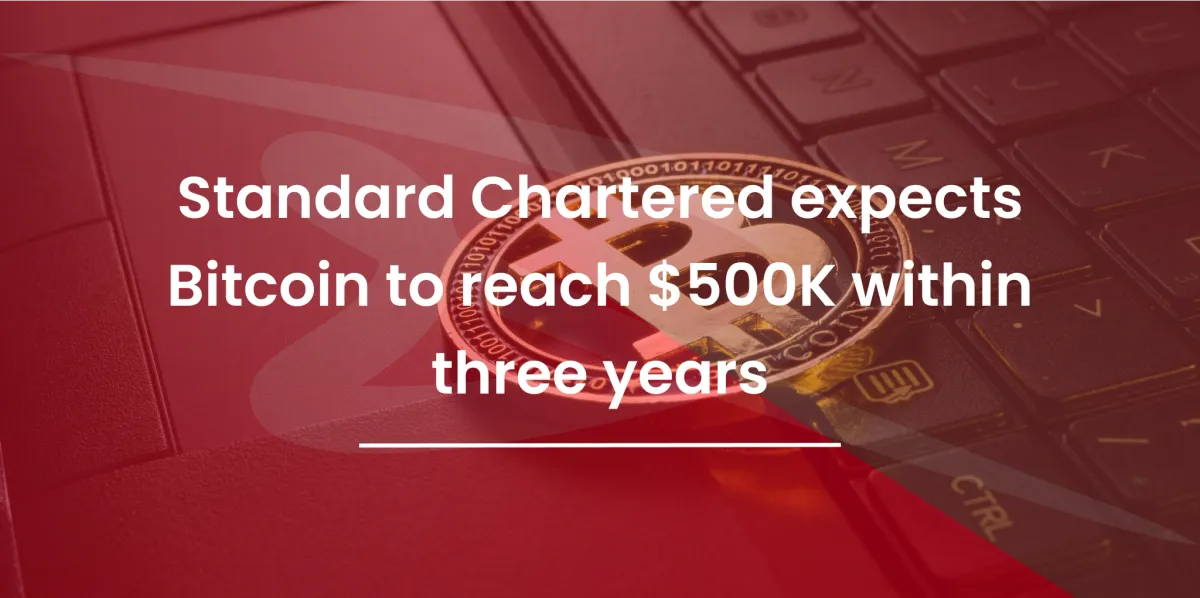Standard Chartered expects Bitcoin to reach $500K within three years
Standard Chartered predicts Bitcoin could hit $500,000 by 2028, driven by institutional adoption, ETFs, and regulatory clarity.

In recent years, Bitcoin has become one of the most discussed financial assets, with analysts and investors speculating on its future price trajectory. Standard Chartered Bank has now entered the debate with a bold prediction that Bitcoin’s price could skyrocket to an astonishing $500,000 by 2028. Geoffrey Kendrick, the head of forex and digital assets research at Standard Chartered, attributes this surge to increasing institutional adoption, regulatory clarity, and macroeconomic trends.
This forecast has sparked discussions among financial experts, crypto enthusiasts, and prominent investors such as David Sacks. As Bitcoin continues to mature, it faces regulatory developments under Trump’s crypto policies and executive orders aimed at strengthening digital asset security measures. With the growing influence of the working group focusing on cryptocurrency oversight, Bitcoin's institutional acceptance is expected to accelerate.
Key Drivers Behind the Prediction

Institutional Adoption
One of the primary catalysts for Bitcoin’s projected rise is increasing institutional investment. Large financial firms, hedge funds, and publicly traded companies are integrating Bitcoin into their portfolios. Standard Chartered Bank suggests that as Bitcoin ETFs gain traction, institutional demand will surge. Currently, institutions have already poured over $39 billion into Bitcoin-related assets, reinforcing its legitimacy in mainstream finance.
Regulatory Clarity and Security Measures
The role of regulatory frameworks is critical in shaping Bitcoin’s future. Standard Chartered Bank emphasizes the impact of executive orders related to digital assets, taxation policies, and security measures designed to protect investors. The evolving working group on cryptocurrency regulation is expected to introduce policies that enhance market stability and credibility. With a structured legal framework, Bitcoin becomes a more attractive asset for both institutional and retail investors.
Bitcoin as Digital Gold
Bitcoin is increasingly seen as a digital alternative to gold, with its limited supply and growing recognition as a store of value. Standard Chartered Bank believes that as Bitcoin gains acceptance as “digital gold,” its price will appreciate in response to demand and scarcity. Currently, gold’s market capitalization stands at $19.3 trillion, and Bitcoin's market dominance continues to grow as a viable competitor.
Standard Chartered’s Price Projections
Standard Chartered Bank has provided a detailed timeline for Bitcoin’s price growth:
- 2025: $200,000
- 2026: $300,000
- 2027: $400,000
- 2028: $500,000
The bank expects Bitcoin’s price to stabilize around this level through 2029, with market maturity and reduced volatility.
Risks and Considerations

While Standard Chartered’s forecast is optimistic, Bitcoin’s price remains volatile due to market sentiment, geopolitical events, and technological advancements. The bank acknowledges that the cryptocurrency market is influenced by factors such as Trump’s crypto stance, global economic conditions, and unexpected regulatory shifts.
Despite these risks, Standard Chartered remains confident in Bitcoin’s potential to reach $500,000, driven by institutional adoption, favorable regulations, and its role as a hedge against inflation. With increasing mainstream acceptance, Bitcoin's trajectory toward new all-time highs appears more plausible than ever.
Factors Influencing the Prediction

Institutional Involvement and Market Expansion
The increasing involvement of institutional investors is a crucial factor in Bitcoin’s projected growth. Large-scale investments by hedge funds, financial institutions, and corporations have contributed to Bitcoin’s mainstream acceptance. The expansion of Bitcoin-focused investment products, including spot ETFs, has played a significant role in attracting more capital to the market. The continuous development of institutional-grade custody solutions has further enhanced Bitcoin’s credibility and accessibility.
Regulatory Evolution and Legal Frameworks
The global regulatory landscape is evolving, with governments and financial watchdogs working toward implementing clearer guidelines for cryptocurrencies. Enhanced compliance requirements and government-backed policies, such as stricter anti-money laundering (AML) regulations and licensing frameworks for exchanges, could boost investor confidence. Favorable regulatory decisions are expected to create a more stable environment for Bitcoin’s long-term growth.
Bitcoin Halving and Supply Mechanics
Bitcoin’s supply is fixed at 21 million coins, and the process of halving reduces the issuance rate approximately every four years. The next halving event, expected in 2024, will cut Bitcoin mining rewards in half, leading to increased scarcity. Historically, these events have triggered substantial price surges due to reduced new supply entering circulation, aligning with Standard Chartered Bank’s price projections.
Economic Uncertainty and Inflation Protection
Bitcoin is increasingly being perceived as a hedge against inflation and currency depreciation. With central banks printing more money and inflation concerns rising, investors are turning to Bitcoin as an alternative store of value. The correlation between Bitcoin and traditional safe-haven assets, such as gold, is expected to strengthen, reinforcing its role as a long-term wealth preservation tool.
Technological Developments and Scalability Improvements
Advancements in blockchain technology, including the development of Layer 2 scaling solutions like the Lightning Network, are enhancing Bitcoin’s usability. Improved transaction speeds and lower fees are making Bitcoin a more viable payment option. As technological innovations continue, Bitcoin’s overall adoption and integration into financial systems are likely to accelerate.
Market Sentiment and Speculative Trends
Bitcoin’s price movements are heavily influenced by investor sentiment and speculative trading. The role of media, social trends, and institutional endorsements plays a vital role in shaping market dynamics. As Bitcoin gains further legitimacy through institutional backing, speculative volatility is expected to decline, fostering a more sustainable growth trajectory.
Comparative Analysis with Gold
Bitcoin and gold have often been compared as store-of-value assets, with many analysts referring to Bitcoin as "digital gold." Standard Chartered Bank’s prediction that Bitcoin could reach $500,000 further fuels this comparison, suggesting that the cryptocurrency may rival or even surpass gold in terms of market value and investor preference. This section explores the similarities and differences between Bitcoin and gold, examining factors such as scarcity, liquidity, volatility, and institutional demand to understand Bitcoin’s potential trajectory.
Scarcity and Supply Dynamics
One of the most significant similarities between Bitcoin and gold is their scarcity. Gold has a finite supply, with limited reserves available for extraction, making it a valuable asset over centuries. Similarly, Bitcoin’s total supply is capped at 21 million coins, with periodic halvings reducing the rate of new issuance. This fixed supply makes Bitcoin deflationary, much like gold, and fuels the expectation that its price will increase as demand grows.
Unlike gold, however, Bitcoin’s supply mechanism is algorithmically programmed, ensuring predictability. Gold mining operations can adjust based on market demand, but Bitcoin’s supply is immutable, governed by blockchain protocols. Standard Chartered’s projection of Bitcoin reaching $500,000 aligns with the historical price surges observed after previous Bitcoin halvings, which restricted new supply while demand continued to rise.
Liquidity and Market Accessibility
Gold has long been a preferred asset for investors seeking stability, with an estimated market capitalization of $19.3 trillion. It is widely traded through ETFs, futures contracts, and physical ownership. Bitcoin, on the other hand, has gained rapid traction in financial markets, with the introduction of Bitcoin ETFs and increased adoption by institutional investors boosting its liquidity.
Bitcoin has an advantage in terms of ease of transfer. Unlike gold, which requires physical storage and transportation, Bitcoin can be instantly transacted across the globe through blockchain networks. This efficiency makes Bitcoin more practical for modern financial systems, reinforcing the idea that it could eventually challenge gold’s position as the dominant store of value.
Volatility and Market Stability
Despite its similarities with gold, Bitcoin’s price volatility remains a key distinction. Gold has historically exhibited low volatility, making it a reliable hedge against inflation and economic downturns. In contrast, Bitcoin has experienced extreme price swings, with its value fluctuating dramatically within short periods.
Standard Chartered Bank acknowledges this volatility but suggests that as Bitcoin gains institutional adoption and regulatory clarity, its price stability could improve. The market’s response to events such as interest rate hikes, geopolitical tensions, and monetary policy shifts will play a crucial role in determining whether Bitcoin can achieve gold-like stability over time.
Institutional Demand and Portfolio Diversification
The increasing institutional investment in Bitcoin suggests a shift in traditional portfolio strategies. Historically, gold has been the go-to asset for portfolio diversification, with central banks and hedge funds holding significant reserves. However, major corporations and institutional investors are now considering Bitcoin as an alternative hedge against inflation and currency devaluation.
Standard Chartered Bank’s bullish outlook aligns with the trend of institutions integrating Bitcoin into their asset management strategies. As Bitcoin continues to mature and regulatory concerns diminish, its presence in diversified investment portfolios may grow, further legitimizing its comparison to gold.
Future Outlook: Will Bitcoin Overtake Gold?
While Bitcoin’s market capitalization is still significantly smaller than gold’s, its rapid adoption rate, increasing scarcity, and technological advantages suggest that it could challenge gold’s dominance in the coming years. Standard Chartered Bank’s projection of Bitcoin reaching $500,000 implies that its market cap would approach that of gold, redefining the global store-of-value landscape.
However, challenges remain. Gold has a centuries-old reputation as a safe-haven asset, while Bitcoin’s regulatory landscape and security concerns are still evolving. Whether Bitcoin can fully replace gold depends on future technological advancements, regulatory frameworks, and macroeconomic factors that shape global financial markets.
Implications for Investors

Bitcoin’s potential rise to $500,000 presents both opportunities and risks for investors. As institutional adoption increases and Bitcoin secures a stronger position in global finance, long-term investors could benefit from significant price appreciation. However, the volatile nature of the cryptocurrency market necessitates strategic investment approaches.
For retail investors, Bitcoin’s future trajectory suggests the importance of portfolio diversification. Rather than going all-in on Bitcoin, financial advisors recommend allocating a portion of investments to cryptocurrencies while maintaining traditional assets such as stocks and bonds. Bitcoin’s role as a hedge against inflation also makes it an appealing option for risk-conscious investors seeking protection from economic uncertainties.
Institutional investors, including hedge funds and financial firms, are already leveraging Bitcoin’s increasing mainstream adoption. The approval of Bitcoin ETFs and structured investment products has opened new avenues for large-scale capital inflow into the crypto market. Standard Chartered Bank suggests that as Bitcoin becomes more deeply integrated into global finance, institutional involvement will continue to rise, further stabilizing its price.
However, investors must remain mindful of regulatory developments. Government policies, executive orders, and taxation rules could impact Bitcoin’s long-term viability. While regulatory clarity is expected to enhance investor confidence, unforeseen policy shifts could introduce market instability. As a result, investors should stay informed about legislative changes affecting digital assets.
Conclusion
Standard Chartered Bank’s forecast that Bitcoin could reach $500,000 underscores the growing confidence in cryptocurrency’s role in the financial ecosystem. With increasing institutional adoption, regulatory clarity, and Bitcoin’s positioning as digital gold, its value trajectory appears poised for long-term growth. The approval of Bitcoin ETFs, the impact of future executive orders, and macroeconomic trends all contribute to the digital asset’s bullish outlook.
Despite Bitcoin’s volatility, its potential as a hedge against inflation and a viable alternative to traditional assets makes it an attractive option for investors. While risks remain, the overall sentiment surrounding Bitcoin’s future remains optimistic. As the financial landscape continues to evolve, Bitcoin’s journey toward new all-time highs will be closely monitored by investors and analysts alike.




Comments ()